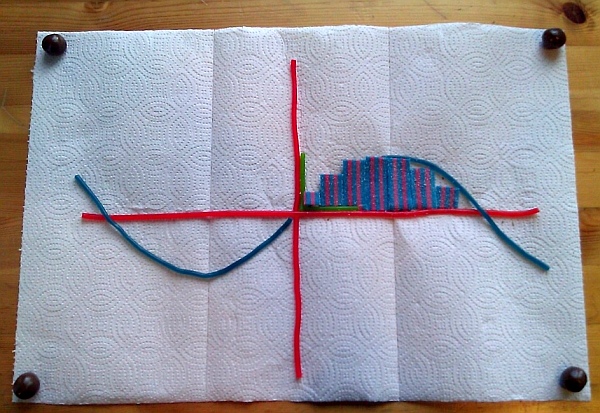Wikipedia does a pretty good job of giving a rough idea why it's the case, check out the 'Geometric intuition' bit of http://en.wikipedia.org/wiki/Fundamental_theorem_of_calculus
The answer to this question is a lot easier to understand graphically, but basically you have to imagine that in , the f(x) is the height of a rectangle and the dx is some arbitrarily small width of that rectangle. The integral means, in essence, adding up all the rectangles - which amounts to finding the total area under the curve.
Edit: this is not really super helpful in terms of answering your question, but is roughly relevant and amused me. Why don't I think of things like this?

Edit: this is not really super helpful in terms of answering your question, but is roughly relevant and amused me. Why don't I think of things like this?

(edited 12 years ago)
Original post by Claree
Please could someone explain to me WHY calculating a definite integral finds you the area under a curve?
Or, if you want to go more in depth, check out the Riemann Integral
tbh, it depends what you define an integral to be.
Original post by Claree
Please could someone explain to me WHY calculating a definite integral finds you the area under a curve?
I am not sure if i am right, but in my opinion this is the case,
You would have probably studied calculating area by using trapezium rule, in that rule we use strips.
In integration, we use infinite strips.
The area of one strip will be, Area= where delta x is very small, almost zero.
Now summing the strips,
As , the summation becomes integration,
Hope i am correct.

Strictly speaking, it's because the integral is what we define the "area under a curve" to be, and the fact it's consistent with the definition of area for simple shapes is what allows this definition to make sense.
(edited 12 years ago)
the area (called the Riemann integral) is the limit of the riemann sum over the certain interval - end points (a,b), divided into intervals of equal length b-a/l, with a point c in each interval. Sum is then SIGMA i=0 to n-1 of f(c_i)(x_i+1-x_i)
basically:f(c_0)(x_1-x_0)+f(c_1)(x_2-x_1)+f(c_2)(x_3-x_2)+.....+f(c_n-1)(x_n-x_n-1)
basically:f(c_0)(x_1-x_0)+f(c_1)(x_2-x_1)+f(c_2)(x_3-x_2)+.....+f(c_n-1)(x_n-x_n-1)
Quick Reply
Related discussions
- Parametrics
- Maths parametric integration
- AS Maths edexcel 2023
- What are the benefits of Integration of Social Trading Features in Custom Software
- Alevel maths q help needed
- polar coordinate question help
- Calculating volume
- Kinematics help a level
- A-level Maths, Integration, Finding area between curves & Lines.
- is it just me or is this question incomplete??
- stuck on maths distribution question
- Calculator Error - Normal Distribution
- physics help
- Help integration
- Volumes of revolution
- Pure Math Cie A level
- Intergrate
- Help urgently maths
- Chem a level: Maxwell -Boltzman Distribution Curve, why does height of peak decrease?
- AQA A Level Mathematics Paper 1 (7357/1) - 6th June 2023 [Exam Chat]
Latest
Last reply 1 minute ago
Zoom to Zoology? Uni open days, applications & more 2021-Present - a parents takeLast reply 2 minutes ago
Official Dental Hygiene and Therapy (Oral Health Science) 2024 Entry ThreadDentistry
2839
Last reply 3 minutes ago
Edexcel A Level History Paper 1 (9HI0 1A-1H) - 23rd May 2024 [Exam Chat]Last reply 3 minutes ago
JK Rowling in ‘arrest me’ challenge over hate crime lawPosted 5 minutes ago
A Day in the Life of a Media Communications Student at the University of RoehamptonLast reply 5 minutes ago
University of Salford Student Life : Connect with Salford Ambassadors and Graduates!Last reply 6 minutes ago
Official LSE Offer Holders Thread for 2024 entryLast reply 8 minutes ago
Accomodation in UK for Royal Holloway student - Sep 2024Last reply 8 minutes ago
Psychology with foundation year -liverpool hope 2024Last reply 9 minutes ago
Inlaks, Commonwealth, and Other Scholarships for Indian Students 2024: ThreadLast reply 9 minutes ago
Official Cambridge Postgraduate Applicants 2024 ThreadLast reply 10 minutes ago
Official University of Edinburgh Applicant Thread for 2024Posted 10 minutes ago
Work Experience Help (16 years old, Year 12)Last reply 11 minutes ago
Accenture Degree Apprenticeship 2024Last reply 12 minutes ago
UAL Bsc Fashion Management and fashion marketingPosted 12 minutes ago
SOAS for MA South Asian Area Studies or LSE for International and Asian History?Last reply 15 minutes ago
Official: University of Leicester A100 2024 Entry ApplicantsTrending
Last reply 1 week ago
Edexcel A Level Mathematics Paper 2 unofficial mark scheme correct me if wrongMaths
71
Trending
Last reply 1 week ago
Edexcel A Level Mathematics Paper 2 unofficial mark scheme correct me if wrongMaths
71




